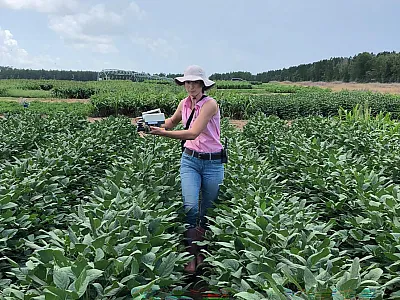Managing legacy phosphorus with 4R nutrient stewardship
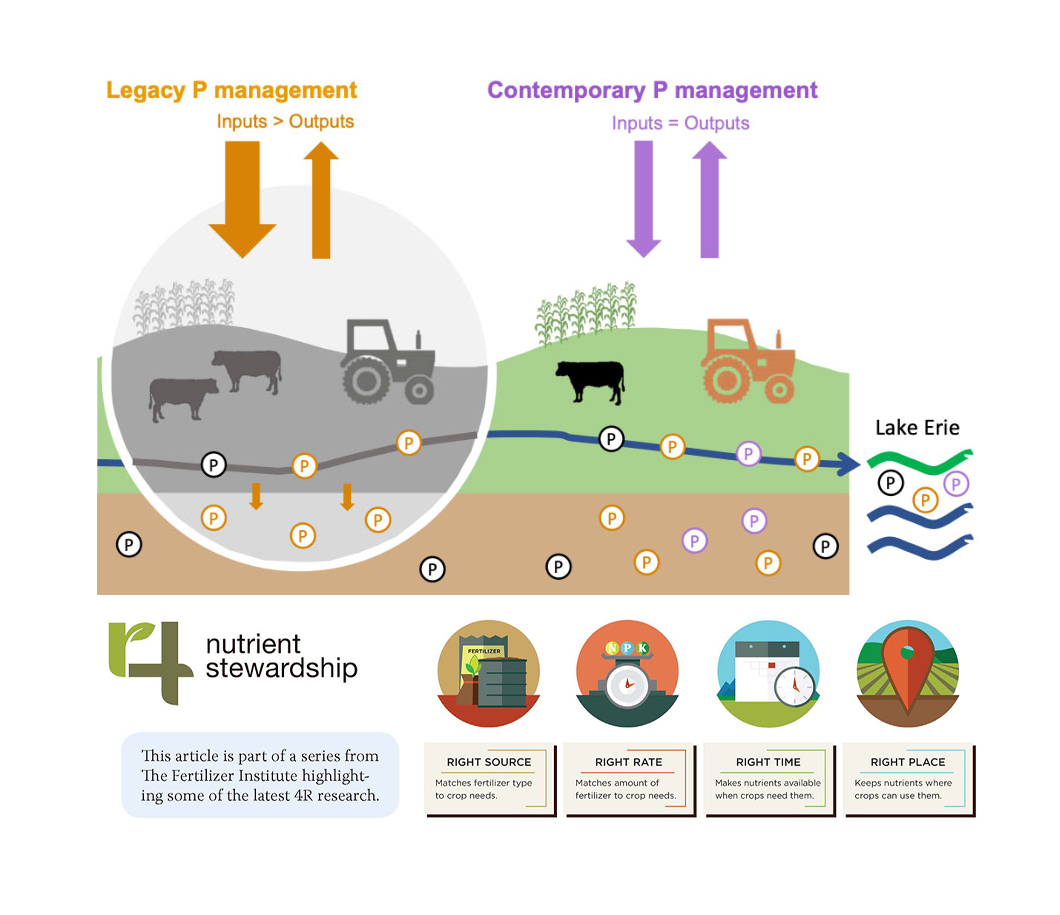
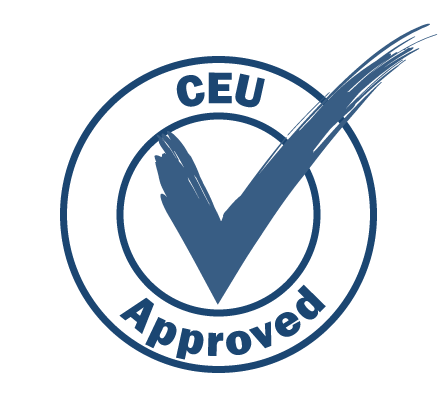
Legacy phosphorus is an evolving concept useful in the responsible management of crop nutrition. A cumulative balance of inputs and outputs is part of responsible management of plant nutrition and 4R nutrient stewardship. This cumulative balance can be used to compare fields that have differed in their historical inputs and productivity and identify where current replenishment, deficit, and surplus rates are appropriate. In addition, the legacy concept is also useful for situations in which soil testing is impractical.
Earn 0.5 CEUs in Nutrient Management by reading this article and taking the quiz.
Legacy phosphorus (P) is commonly understood as the P in soils that has carried over year to year, contributing to both crop nutrition and environmental challenges with water quality. The term is recognized as the P remaining in soils, rather than the P most recently contributed through fertilization. It is frequently associated with historically manured landscapes and often associated with water quality issues.
Scientists espousing a sustainability perspective use a broader definition. Legacy P can be defined to include the P in agricultural soils as well as that found in the sediments of streams, rivers, reservoirs, and estuaries. It is recognized not only as the amount of P accumulated in soil, but also its forms and their spatial distribution among soil depths, landscape positions within fields, and distribution among different farming systems.
Examples of recently published scientific definitions of legacy P include
“The P accumulated in soil through human activity, based on the definition of legacy as something received from the past or carried over from past actions” (Turner & Kim, 2024).
“The P within the environment (e.g., sediments, water bodies, soils) resulting from historic human activity, excluding geogenic P stores” (Shober et al., 2024).
“The P that exists in soils and catchments as a result of either past anthropogenically released rock phosphate-derived P, or of human impacts on P fluxes in aquatic systems, including non-fertilizer P sources (e.g., sediment loading via erosion)” (Margenot et al., 2024).
Cumulative balance of inputs and removals
While legacy P is not easy to define or measure, the cumulative balance of inputs and removals (surplus or deficit) on agricultural land is a major part of its description. Many regions of the world with high crop yields have a considerable cumulative surplus of P, meaning more P is added than removed over time. On a national scale, 82% of the world’s countries have a historical cumulative surplus of P since 1961 (FAO, 2024). While the soils may be at a cumulative surplus, these countries also account for 87% of current removal of P by crop harvest. Maintaining a surplus P balance supports the current high levels of cropland productivity.
The partial P balance for cropland in the United States from 1961 to 2022 shows a surplus accumulating since 1961 to about 20 times current annual crop removal (Figure 1). More recently, in the past decade and a half or so, the annual inputs match crop removal more closely; thus, the cumulative surplus has plateaued.
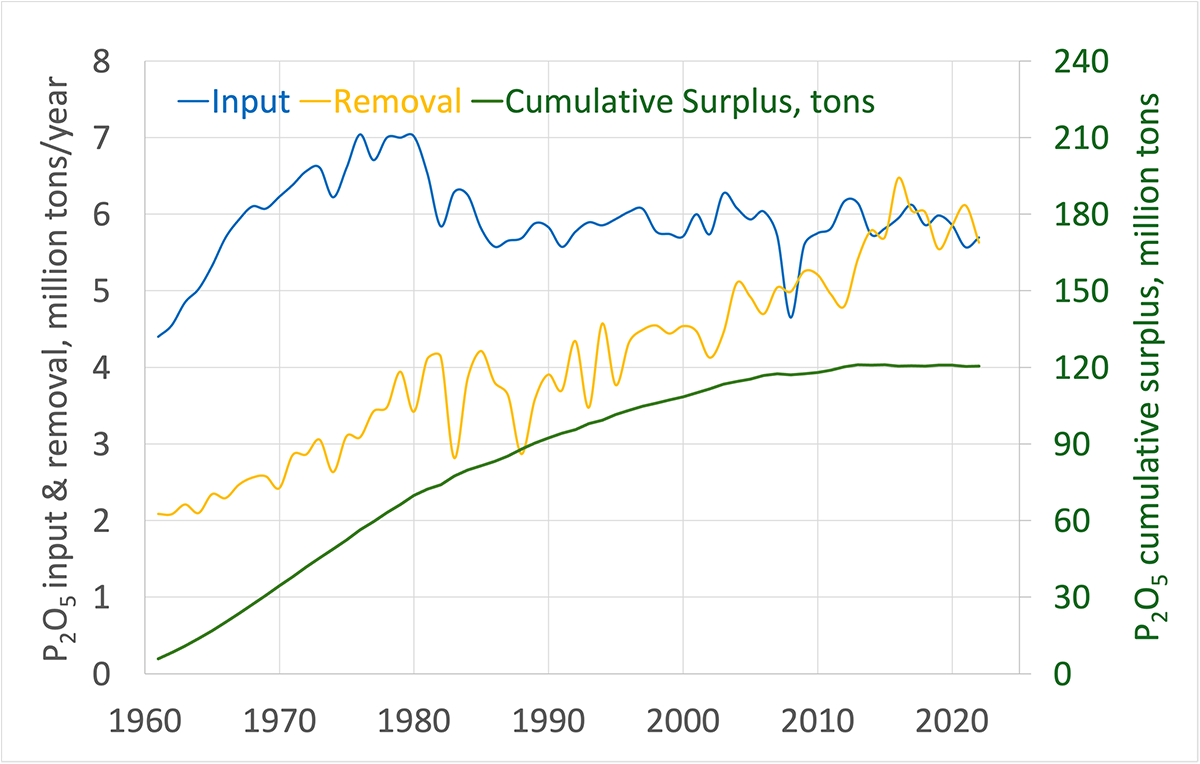
This surplus, however, is not evenly distributed among farms and fields, but includes areas of deficit as well as surplus. As a result, cropland soils vary widely in the amount of P accumulated or depleted. This is confirmed by the broad distribution of soil test P levels in U.S. cropland (Figure 2). In 2020, 46% of soils tested below critical (TFI, 2020). Thus, though cropland may be at a surplus P according to a national nutrient balance, there are still plenty of instances of P need across U.S. cropland.
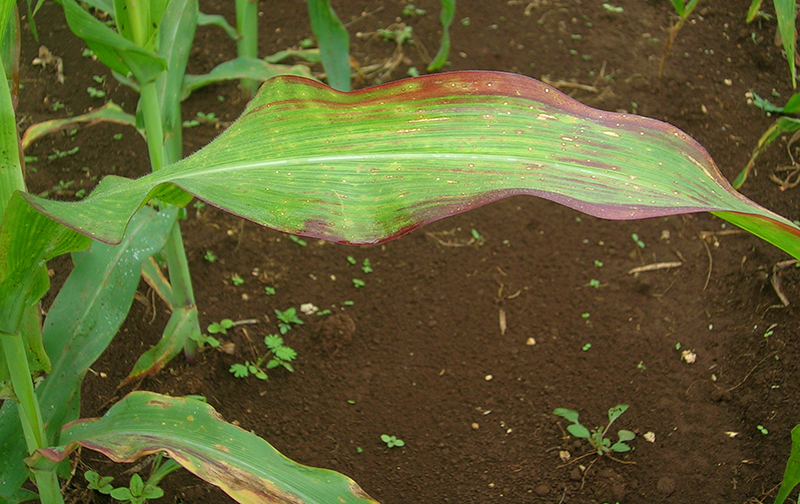
Soil tests reflect a substantial part of cropland P legacy. Though many definitions of legacy P do not consider P deficit, it is especially important when considering U.S. cropland. In the U.S., there is a continued presence of P-deficient soils though the overall nation is at a level of considerable P surplus. It is important to account for P deficit since the depletion of soil P may constrain future productivity.
If the surplus areas coincided with the areas with low soil tests, and the deficits with high soil tests, we would expect to see some convergence of soil test levels toward an optimum. The fact that we don’t see it in Figure 2 indicates room for improvement in the distribution of P inputs.

Describing legacy P in soils is complicated by the fact that both natural and human-induced factors are at work. Phosphorus in most soils originates as calcium phosphate minerals in the parent material. As soils weather, the forms of P as phosphate bound to iron and/or aluminum and/or organic matter become more prominent.
Early research on P nutrition of crops—more than 175 years ago—found that optimum yields required P inputs considerably larger than the amounts removed in crop harvests. Based on these early observations, many presumed that much of what was applied was irreversibly fixed in the soil in unavailable forms and that an ever-increasing P surplus was inevitable. Over time, that understanding has changed. Following years of surplus applications, the accumulated poorly available P provides a source that replenishes the more available forms, resulting in a situation where optimum yields can be attained with inputs roughly equal to crop removals.
Legacy P: benefits and risks
Recently, Barrow et al. (2022) pointed to three benefits of legacy P. First, added phosphate slowly penetrates soil particles through solid-state diffusion, increasing their negative charge and reducing P sorption and soil P-buffering capacity. A second benefit is that this diffusive penetration eventually slows and stops. The third benefit is that the natural processes transforming soil P to less soluble forms are slowed. Thus, over time, a legacy of surplus P input to the soil allows crops to be sufficiently fertilized with amounts of P no greater than those removed by the previous crop.
These transformations, however, also increase the risk of P loss in drainage water. Reduced buffer capacity reduces the soil’s capacity to retain added P. Tools to assess risk of P loss usually include the use of some form of soil test P to identify soils with low P-buffering capacity, on which the application rates of manure and fertilizer should be limited. Such tools also include conservation practices to reduce the risk of P loss by soil erosion as well. Soil erosion from both cropland and from streambanks can be considered important components of legacy P as well (Margenot et al., 2023).
Phosphorus and 4R nutrient stewardship
Management of P in agricultural soils is guided by the principles of 4R nutrient stewardship, seeking to apply the right source of P at the right rate, in the right place, and at the right time.
Source
The main source, fertilizer P, is manufactured from phosphate rock through acidulation followed by processing into granular or fluid forms. Phosphorus fertilizers are often ammoniated, meaning that nitrogen (N) is added to the product (i.e., DAP or MAP). Past resources of P such as guano (bat and seabird excrement) and bones have largely been depleted. Today, large reserves of phosphate rock are known but are geographically concentrated and finite. The return of P to the soil in the form of manure has long been a core farming practice but is challenged in livestock production systems that are geographically decoupled from feed production. Innovators are exploring the extraction of P in concentrated forms from manures and other wastes and the development of fertilizer forms with more controlled release of soluble P.
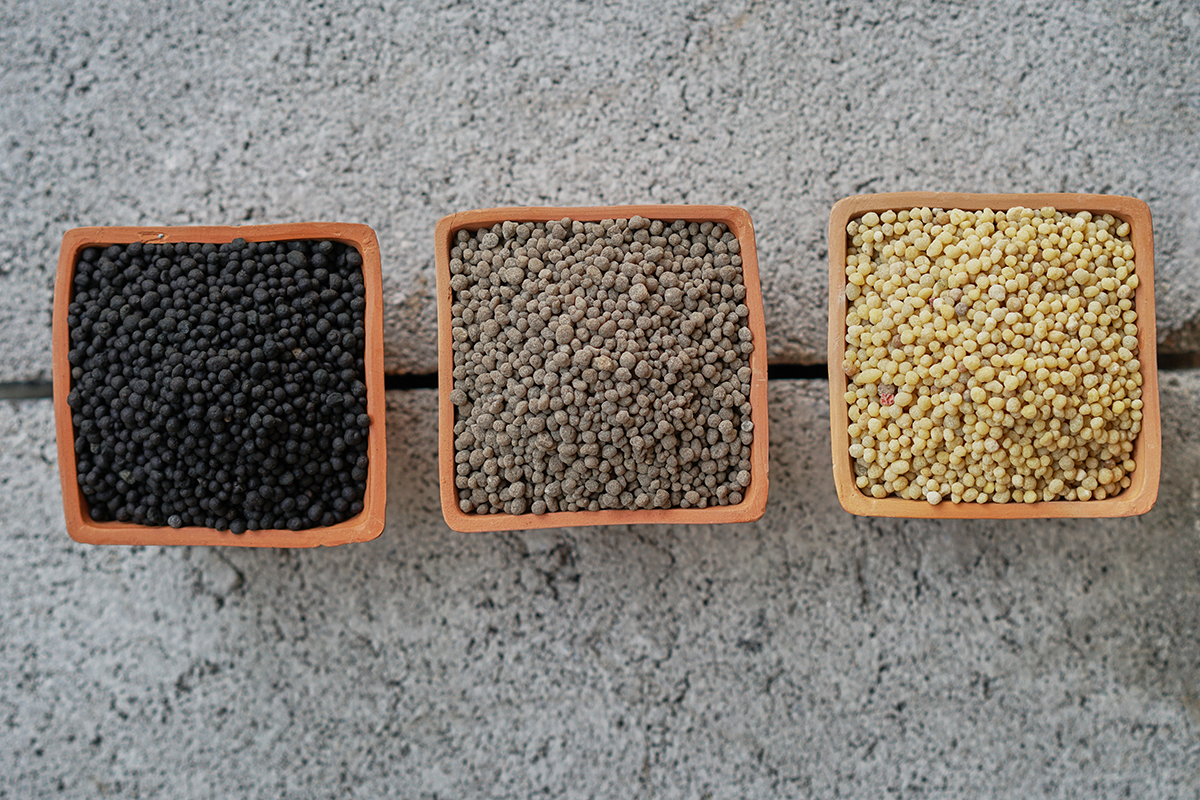
Rate
Soil tests guide rates that optimize yields with minimal P loss. Soils below the critical level may need P input rates higher than crop removal, but soils above the critical level are adequately fertilized with lower rates. When sufficient surplus P accumulates in the soil, the available P reaches a critical level, beyond which it is no longer necessary to apply more P than is removed by the crop. The soil test then becomes the limiter of legacy, setting the rate of application to optimize the management of legacy P. When soils are managed to keep soil P levels near critical, the value of legacy P is optimized. This strategy of building soil test P to an optimum level is more commonly known as the “Build and Maintain” approach. Crops grown in soils above the critical level will obtain much of the P they take up from the legacy pool. Only a small fraction (5 to 30%) comes directly from the fertilizer applied. Much of the rest of the fertilizer application is retained in the soil, replenishing the legacy. In most situations where soil and P applications are well managed, relatively little of the applied P is lost in drainage water.
Time
In some production systems, such as pastures, perennial forages, and some no-till systems, placement of P below the soil surface is not feasible, and P must be applied by broadcasting on the soil surface. Risks of P losses potentially harming water quality can be reduced by applying at times of the season when chances of runoff events are low.
Place
In many crop production systems, there are opportunities to place added P into the soil, rather than leaving it on the soil surface. Subsurface placement reduces incidental losses from the first runoff events following application and reduces the stratification of available P in soils. Utilizing a P starter fertilizer that is placed near or with the seed is often a profitable approach for growers to maximize crop access to P early in the season.
Conclusions
Legacy P is an important consideration when developing 4R nutrient management plans. A cumulative balance of inputs and outputs is part of responsible management of plant nutrition and 4R nutrient stewardship. This cumulative balance can be used to compare fields that have differed in their historical inputs and productivity and identify where current replenishment, deficit, and surplus rates are appropriate. In addition, the legacy concept is also useful for situations in which soil testing is impractical.
Dig deeper
This article is part of a special collection, "Legacy phosphorus: 4R nutrient stewardship, regional conservation, and collaborative, adaptive management."
Barrow, N.J., Roy, D., & Debnath, A. (2022). Evaluating the benefits of legacy phosphate. Plant Soil 480(1): 561–570. doi: 10.1007/s11104-022-05601-3.
Margenot, A.J., Zhou, S., McDowell, R., Hebert, T., Fox, G., Schilling, K., … & Golovay, S. (2023). Streambank erosion and phosphorus loading to surface waters: Knowns, unknowns, and implications for nutrient loss reduction research and policy. Journal of Environmental Quality, 52, 1063–1079. https://doi.org/10.1002/jeq2.20514
Margenot, A.J., Zhou, S., Xu, S., Condron, L.M., Metson, G.S., Haygarth, P.M., Wade, J., & Agyeman, P.C. (2024). Missing phosphorus legacy of the Anthropocene: Quantifying residual phosphorus in the biosphere. Global Change Biology, 30(6), e17376. https://doi.org/10.1111/gcb.17376
FAO. (2024). FAOSTAT and IFA cropland nutrient balance database. http://www.fao.org/faostat/en/#data/ESB.
Shober, A.L., Simpson, Z.P., Jarvie, H.P., Macrae, M.L., Kleinman, P.J.A., Haygarth, P.M., … & Davies, J. (2024). Toward a transdisciplinary and unifying definition of legacy phosphorus. Journal of Environmental Quality, 52, 882–892. https://doi.org/10.1002/jeq2.20659
TFI. (2020). Soil test levels in North America, 2020 summary update. The Fertilizer Institute, Arlington, VA. https://soiltest.tfi.org/charts/distribution
Turner, B.L., & Kim, P.J. (2024). Terminology for residual and legacy phosphorus. Plant and Soil, 501(1), 237–239. doi: 10.1007/s11104-024-06538-5
Self-study CEU quiz
Earn 0.5 CEUs in Nutrient Management by taking the quiz for the article. For your convenience, the quiz is printed below. The CEU can be purchased individually, or you can access as part of your Online Classroom Subscription.
Legacy phosphorus is best defined as the phosphorus
a. most recently contributed through fertilization.
b. lost from agricultural soils by erosion.
c. amounts, forms, and distribution accumulated in soil.
d. that contaminates streams in agricultural watersheds.
The partial phosphorus balance for cropland since 1961 in the United States shows that
a. crop removal far exceeds fertilizer inputs.
b. the cumulative P surplus amounts to 20 times annual P removal.
c. the cumulative P surplus is beginning to decline.
d. the soil test P levels have increased since 2001.
The broad distribution of soil test P levels in North American cropland confirms that the
a. cumulative P surplus was not evenly distributed among farm fields.
b. value of soil testing is limited.
c. soil test P levels are unrelated to historical surpluses of P.
d. opportunity to better distribute P inputs does not exist.
In soils with a history of legacy P and cumulative P surplus
a. risks of P loss in drainage water diminish.
b. risks of soil erosion increase.
c. soils require P inputs greater than crop P removal.
d. soil P buffering capacity decreases and soil P availability increases.
In soils that test above the critical level for P, crops obtain most of the P they take up from
a. the recently applied fertilizer or manure.
b. the legacy P pool in the soil.
c. the P flowing in drainage water.
d. the P irreversibly fixed in the soil.
Text © . The authors. CC BY-NC-ND 4.0. Except where otherwise noted, images are subject to copyright. Any reuse without express permission from the copyright owner is prohibited.






